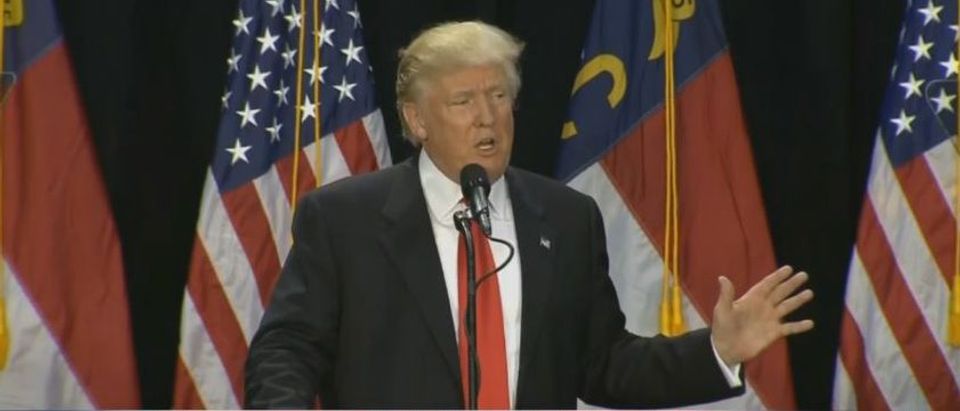Until recently, Donald Trump wasn’t known for discoursing at length on the economic and social plight of African-Americans. In promising to “Make America Great again,” he often seemed to be responding to the cultural insecurities of working class Whites in a society that’s become increasingly multi-ethnic and multicultural.
That’s all the more reason to pay attention to Trump’s latest speeches. The billionaire real estate mogul is attempting a bold feat that is largely unprecedented for a GOP presidential candidate: Blame the Democrats for failing to provide real support to struggling African-American communities and promise to make black needs and aspirations a real priority in a future Republican administration.
Democratic pundits are fond of poking fun at Republicans when they make overtures to minority voters, suggesting that they are “tone-deaf.” And reaction to Trump’s latest “pivot” is drawing much the same reaction. Trump isn’t trusted by African-Americans, critics say, because he helped champion the “birther” movement and often lampoons President Obama as dangerously incompetent. And he too often depicts inner-city blacks as prone to violence and hopelessly impoverished, forgetting that there’s also a large and stable black middle class and even a growing number of black millionaires.
These criticisms are true, up to a point, but they miss why Trump’s message might well resonate. Most African-Americans are indeed hurting and Trump’s right: most of the American cities where African-Americans live have Democratic leaders. And for all their rhetoric about being the party of inclusion, and of African-Americans especially, Democrats have stood by for eight years as the nation’s first black president has failed to come up with meaningful solutions to the problems of urban America.
Democrats have tended to focus on the issue of police violence, highlighting the relatively rare instances in which law enforcement officers overstep their bounds and inflict excessive force on African-Americans. And yet it is precisely here where Trump’s message could gain traction, and especially among those very middle class blacks that his critics seem to think he ignores.
Many African-Americas are as deeply troubled as Trump is by the turmoil and dysfunction that is driving young and poorer blacks into confrontations with local police, and by the mutual misunderstandings that can easily escalate into unnecessary violence. When Trump speaks of the African-Americans who want law and order and a sense of safety and stability to return to their neighborhoods, he’s not talking through his hat. Those African-Americans really exist – and they vote – and in increasingly larger numbers.
And in the end, that may be the real issue. In the last two elections, Obama was able to capitalize on a large African-American voter turnout that helped sweep him to victory in at least eight key battleground states. Those 8 states, which account for roughly 120 electoral votes, are in play again in 2016. Whether Clinton — who is not as popular with African Americans as Obama – can continue the Democrats’ recent African-American voter surge is one of the great unanswered questions in this election cycle.
Right now, Clinton seems to be taking the vote of African-Americans – like that of Latinos – almost completely for granted.
What’s often forgotten is that national elections, especially in key battleground states, are often a game of inches. In 2008 and again in 2012, African-American turnout surpassed White turnout (66% to 64% in 2012) for the first time in presidential history. That means the black share of the electorate increased, and it made a huge and decisive difference in a number of the battleground states.
Take Ohio in 2012. Obama won by 3% with a margin of roughly 166,000 votes. Many Romney supporters assumed – wrongly – that they would prevail because the white turn out would be relatively high, but they vastly underestimated the black turnout, which jumped from 11% of the electorate in 2008 to 13% in 2012. Romney actually performed slightly better among African Americans than McCain had – but it didn’t matter. Thanks to a boosted black turnout rate, Obama prevailed.
This is why Trump’s latest offensive with African-Americans should have Democrats worried. In the earlier stages of the campaign, Trump was demonstrating a remarkable ability to attract African American voters which, combined with his extraordinary appeal among White males, was catapulting him to leads in Ohio and in other key battlegrounds like Florida and North Carolina. Clinton’s huge ad offensive in the battleground states has reversed this trend – but not completely. She’s opened up double digit leads in VA and CO, but in OH and FL, which are ultimately far more important to the electoral map her margins are small and fragile.
The bottom line: Trump need not sway an enormous number of African-Americans in the swing states, especially if he continues to command such a high share of the White vote. A shift of 85,000 black votes to Trump in a state like Ohio could make all the difference.
Trump needs to continue pressing his argument that globalism – in the form of free trade and unbridled low-skill immigration – disproportionately damages the fortunes of African-Americans. Most research on immigration demonstrates that unskilled African Americans and illegal Latino immigrants compete for service jobs in the inner cities and also for semi-skilled jobs in the slaughterhouses and in carpet manufacturing plants as well as in agriculture. That’s one reason African-Americans consistently express doubts about immigration reform and the need for “amnesty” in national polls.
In fact, Trump’s recent offensive appears to be paying off: In the LA Times/USC tracking poll, which shows a close national election generally, Trump’s support among African-Americans has spiked from 5% to 15%, a jump of 10%. If Trump can use his new war chest to target African-American voters in the swing states, where Clinton has operated with impunity thus far, he could well see the same kind of spikes – and an entirely new race.
The opening is there, and this is no time for Trump to hold back.


